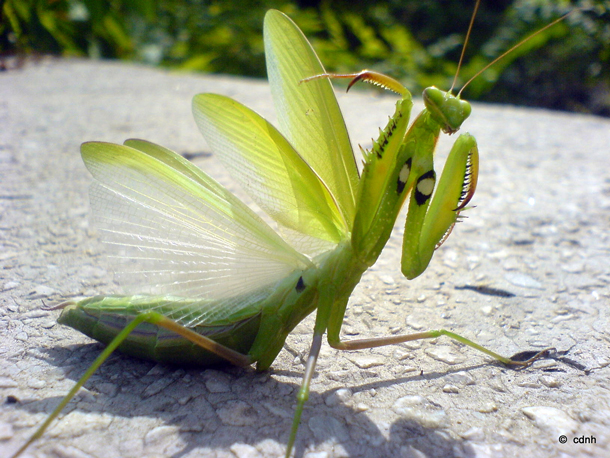Note on Emerging Science: Fear Itself
Air Date: Week of March 30, 2018

Predators like this praying mantis can be threats to others without directly harming the prey – they just need to be scary. (Photo: cdnh, Flickr CC-BY-SA 2.0)
The mere whiff of a praying mantis can be enough to scare fruit flies away from food and sex. As Noble Ingram reports in this week’s Note on Emerging Science, the biological drive to give into fear can be just as disastrous as a genuine threat.
Transcript
CURWOOD: In a minute, how cutting pollution from a coal plant can actually change DNA in babies – but first this note on emerging science from Noble Ingram.
[MUSIC: SCIENCE NOTE THEME]
INGRAM: For President Franklin Delano Roosevelt, in 1933, the hardscrabble path out of the Great Depression had but one roadblock.
ROOSEVELT: Let me assert my firm belief that the only thing we have to fear is … fear itself!
INGRAM: Today, scientists from McGill University and the University of Guelph in Canada have found that what was true 85 years ago may also be true today. The researchers discovered that indications of a lurking predator can cause some fruit flies to abandon behaviors critical to their survival. FDR had a point; fear itself can be deadly.
The team exposed small groups of the tiny insects to the scent of a hungry praying mantis. Alerted to nearby danger, the flies avoided activities like eating and reproducing, which would leave them vulnerable. After the initial puff of mantid perfume, the risk of a total die-off increased seven-fold.
As it turns out, the size of these isolated populations played a critical role. Fruit flies compete for resources and in large numbers, suffer from excess competition. But the team found that smaller, otherwise-unstressed populations actually suffered more from fear than larger groups. When all other environmental factors encouraged these flies to eat and breed freely, the creeping sense of danger interfered.
This curious biological phenomenon is known as the Allee effect and it poses serious problems for struggling species, especially social animals like meerkats or starlings. As the saying goes, there’s safety in numbers, and it’s possible that for many prey animals, the fear that comes with losing your network is just as dangerous as the reality of a predator. Having no one to keep a lookout -- even if nothing is really there -- can spell disaster.
So in times of uncertainty, remember what FDR said, and keep your friends close -- even if only for the peace of mind.
That’s this week’s Note on Emerging Science. I’m Noble Ingram.
[MUSIC: SCIENCE NOTE THEME]
Links
The original study in Proceedings of the Royal Society B: Biological Sciences
Living on Earth wants to hear from you!
Living on Earth
62 Calef Highway, Suite 212
Lee, NH 03861
Telephone: 617-287-4121
E-mail: comments@loe.org
Newsletter [Click here]
Donate to Living on Earth!
Living on Earth is an independent media program and relies entirely on contributions from listeners and institutions supporting public service. Please donate now to preserve an independent environmental voice.
NewsletterLiving on Earth offers a weekly delivery of the show's rundown to your mailbox. Sign up for our newsletter today!
 Sailors For The Sea: Be the change you want to sea.
Sailors For The Sea: Be the change you want to sea.
 The Grantham Foundation for the Protection of the Environment: Committed to protecting and improving the health of the global environment.
The Grantham Foundation for the Protection of the Environment: Committed to protecting and improving the health of the global environment.
 Contribute to Living on Earth and receive, as our gift to you, an archival print of one of Mark Seth Lender's extraordinary wildlife photographs. Follow the link to see Mark's current collection of photographs.
Contribute to Living on Earth and receive, as our gift to you, an archival print of one of Mark Seth Lender's extraordinary wildlife photographs. Follow the link to see Mark's current collection of photographs.
 Buy a signed copy of Mark Seth Lender's book Smeagull the Seagull & support Living on Earth
Buy a signed copy of Mark Seth Lender's book Smeagull the Seagull & support Living on Earth

